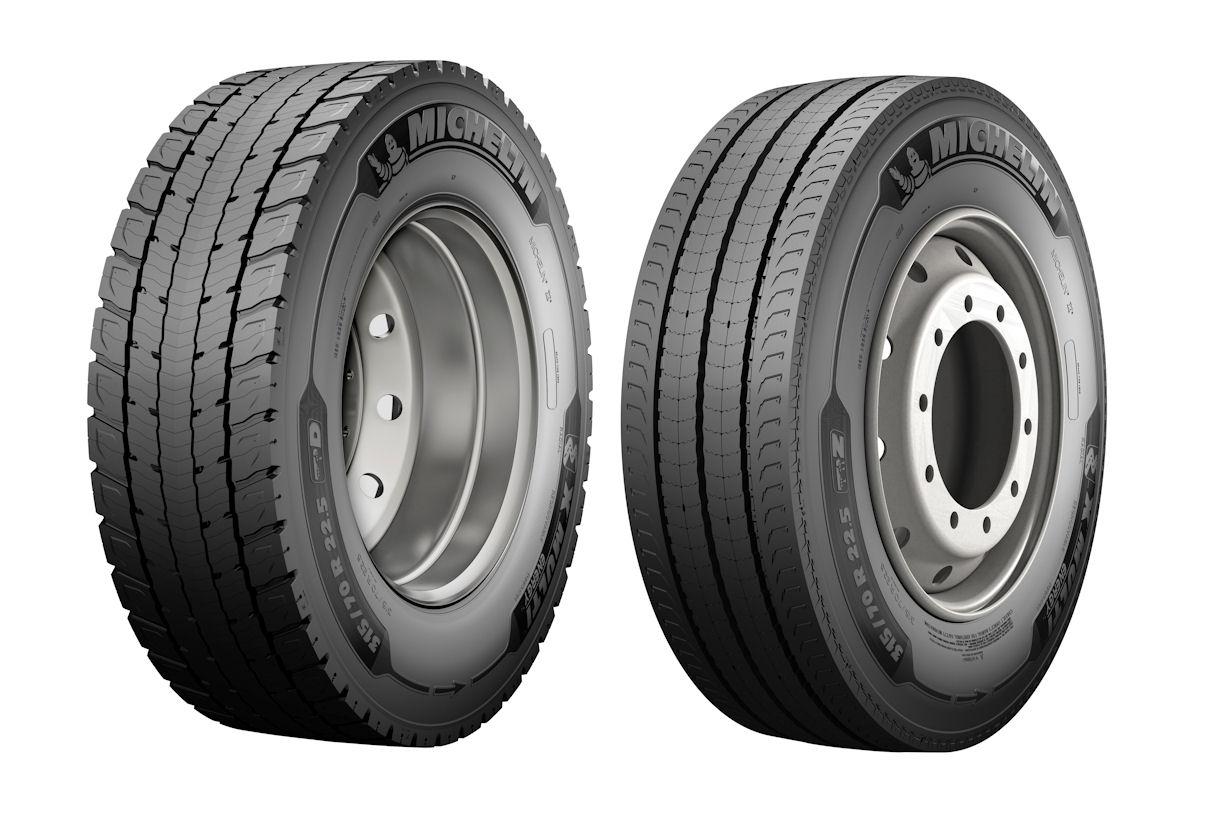Michelin launches X Multi Energy, its first fuel saving tyre for regional transport
 Michelin X Multi Energy D drive axle pattern (l) & X Multi Energy Z all-round fitment
Michelin X Multi Energy D drive axle pattern (l) & X Multi Energy Z all-round fitment
A new range of Michelin tyres aimed at regional haulage operations is now available; these are positioned as products for fleets that place a priority on saving fuel. The introduction of the Michelin X Multi Energy marks the first time the company has launched a dedicated fuel-saving tyre outside of the long-haul sector.
Its arrival is the next step in Michelin’s product replacement strategy for the X MultiWay 3D regional tyre that began with the launch of the first sizes in the new X Multi range in 2017. The headline news when the X Multi arrived last year was that it matched its predecessor’s fuel efficiency yet delivered up to 20 per cent more mileage.
Michelin says extensive testing with the X Multi Energy has demonstrated a fuel saving of up to 1.2 litres per 100 kilometres compared to the X MultiWay 3D (using the VECTO calculation), whilst equalling its predecessor’s mileage potential. Furthermore, Michelin says calculations with the VECTO tool show that the X Multi Energy tyres can save 1.1 litres of fuel per 100 kilometres over the average of the tyre’s three premium competitor rivals.
“This new X Multi Energy is a first for Michelin, and operators in the UK and Ireland are ideally positioned to benefit from it given that regional haulage accounts for a significant proportion of all on-road missions,” says Chris Smith, sales director B2B for Michelin in the UK and Ireland. “It gives regional hauliers and own-account operators a clear choice dependent on their preference for tyre longevity or fuel saving.”
Fuel is the second highest cost for haulage operators and industry trends are towards cleaner, ‘greener’ transport. The European Commission is following a roadmap to reduce the CO2 emissions from road transport, and as part of this the EU has developed with partner stakeholders the abovementioned VECTO tool to calculate the fuel consumption and CO2 emissions of trucks. From 1 January 2019, all OEMs must declare the CO2 emissions for their new trucks (16 tonnes and larger; trucks 7.5 tonnes and above from 1 January 2020) sold on the European market, as calculated by the VECTO tool.
Smith adds: “This launch means regional operators can now make a clear choice in favour of fuel saving and CO2 reduction. Our larger customers tell us this is becoming increasingly important as most tender documents and contracts are demanding a low CO2 operation. This makes X Multi Energy the perfect solution – bringing all of the experience we’ve gained with the X Line Energy long-distance product, to regional operators for the first time.”
Fuel costs are high on the agenda for all road transport companies, but Michelin comments that surprisingly few appreciate that tyres are responsible for one third of the fuel consumption of a typical tractor unit and trailer combination. Aerodynamic drag and internal mechanical friction are responsible for the remainder.
A trio of Michelin technologies are used in the X Multi Energy: Infinicoil, Regenion and Powercoil; these feature in both the drive axle and all-round tyre fitments.
Infinicoil is a continuous steel wire, up to 400 metres long, wrapped around the tyre to provide greater tread stability and results in enhanced fuel savings, and increased tyre life.
Regenion technology (a result of intricate 3D metal printed moulds) produces regenerating tread blocks which evolve as the tyre wears. This maintains the void ratio in the tread pattern, and consequently the water clearing capability and grip throughout the tyre’s life.
Powercoil is the new generation of more robust steel casing cables; these are lighter and provide better endurance and help reduce the rolling resistance.
Designed to be regrooveable and retreadable via the Michelin Remix process, the Michelin X Multi Energy is both 3PMSF and M+S marked. Michelin says the new tyre has been “fully adapted and homologated by all the major truck OEMs,” and is also available on the replacement market with immediate effect as a 315/70 R 22.5 fitment in both all-round fitment and drive axle patterns.




Comments